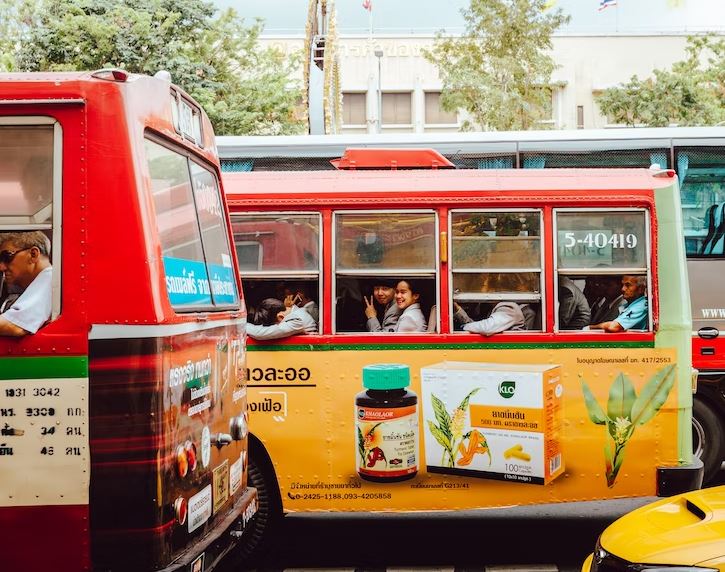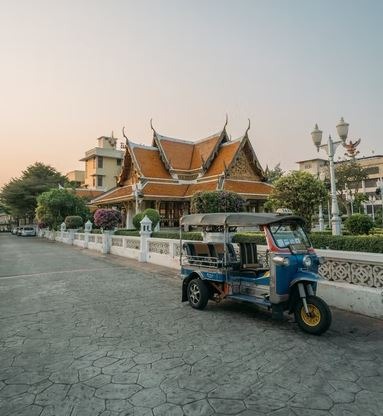Bangkok Public Transport is a vital component of city life in this sprawling metropolis of over ten million inhabitants. These public transportation options can help you go to the famous Khaosan Road. With these, you can experience the best things to do in Bangkok. Here is a guide to the vast public transportation network’s operation because it can be confusing for most first-time visitors. We discuss the following Bangkok Public Transport-related topics in this article.
General Information About Public Transport In Bangkok
Bangkok traffic is notoriously chaotic, especially when compared to Western cities, and you might think there are no rules on the Thai roads. We advise against trying to drive yourself because Thailand has the second-highest annual road fatality rate in the world, with 24,000 deaths, according to the World Health Organization. There are a few exceptions to Bangkok’s fantastic, safe, and comfortable public transportation system, which we’ll discuss in more detail below.
Bangkok’s typical rush hours are from 7:00 to 9:00 in the morning and from 4:30 to 8:00 in the evening. but the majority are constantly busy. You want to avoid getting stuck in traffic because you could easily spend two hours stationary in areas like Sukhumvit Road. This list of public transportation options in Bangkok has been divided into four categories: travel by road, boat, train, and to and from airports. To give you a complete picture of all your options, we’ve also included some non-public transportation on this list.
Travel By Railway
- BTS Skytrain
Any Bangkok resident will always prefer the BTS over the MRT because it is the fastest mode of public transportation in the city. The BTS, also referred to as the Skytrain, is an elevated rapid transit system that carries more than 650,000 people each day. This cutting-edge rail system will transport you to the opposite side of the city in an hour and has excellent air conditioning for comfort.
The Sukhumvit Line and the Silom Line are two different BTS lines in Bangkok that cover its most significant neighborhoods. Travelers can change between the Sukhumvit and Silom Lines at the Siam BTS Station and connect to the MRT System at the Asok, Mo Chit, and Silom BTS Stations, though recently the line has been extended. Today, you can travel to Samut Prakan by BTS from the center of Bangkok.
- MRT Metro
The MRT is yet another enduring favorite of mine in Bangkok Public Transport. This metro system has two distinct lines, the Blue Line and the Purple Line, just like the BTS. Travelers can change between lines and the MRT and BTS systems at the stations of Sukhumvit, Chatuchak Park, and Silom. Although the BTS and MRT stations can get very busy during rush hour, taking them is still preferable to getting stuck in traffic. In Sukhumvit, for instance, the MRT Connection is so congested that you typically have to wait an additional fifteen minutes. However, waiting in a taxi at Sukhumvit Road could take up to two hours.
You must purchase either an MRT Pass or a single-journey token to ride the MRT. For 120 THB, travelers can purchase a day pass, just like the BTS. It is not possible to use an MRT day pass for a BTS ride because the railway systems are operated by different companies. The MRT Lines are open from 6:00 until 0:00.
- Train
Although it’s not the best way to get around Bangkok, the train system is a great way to explore other parts of Thailand. A convenient, affordable, and secure option for many visitors is to take the train to the north or south of the nation. Modern trains come with a variety of amenities, including power outlets and air conditioning. Although they are reasonably priced, these trains are incredibly slow. The beds in night trains, like the one to Laos, have recently washed sheets. There are three classes on each train, with First Class being the most opulent.
Travel By Road
- Taxi
The limited railway infrastructure in Bangkok makes using a taxi another common means of transportation. Any taxi with a red light in front of the window screen is available for hailing. An excellent mode of transportation, taxis are much safer than tuk-tuks or motorcycles. In addition to having leather seats and seatbelts, taxis frequently have air conditioning, which makes for a much more comfortable ride.
- Bangkok Airport Taxi
The taxi rank is located on the first floor of Suvarnabhumi Airport. To get a ticket to take a taxi from there, go to the airport’s ticket office. They will point you in the direction of the parking lot and your taxi. The taxi driver is required by law to add a 50 THB fee on top of the fare. Since most cab drivers use the highway, you will also be responsible for additional toll fees. The total cost of transportation from the airport to central Bangkok is typically up to 400 THB. Again, it might be more affordable and comfortable if you travel in a group. The only drawback is that since most taxis are compact sedans, they won’t have enough room for all of your luggage. When taking a taxi at the airport with a group, request one of the larger taxi vans.
- Grab
You can order a private taxi through the Grab service for a marginally lower cost, and the service is accessible throughout Southeast Asia. Grab is better for long-distance trips only, though, as taxis are already reasonably priced. It was slightly less expensive than a taxi when I used it once or twice in the last two years, but I had to wait a very long time for the driver to arrive. Except in touristy and nightlife areas, where I rarely have issues with drivers, I prefer to take a regular taxi.
- Tuk-Tuk
Despite how recognizable they are, I wouldn’t advise using a tuk-tuk. The amount of pollution you’ll breathe while driving one of these around the city is insane, in addition to the fact that they are uncomfortable and unsafe. Additionally, tuk-tuk drivers are notorious for their scams and frequently charge exorbitant rates for short distances. You constantly have to haggle, which makes you feel taken advantage of. Taxis are significantly more convenient, affordable, and safe.
- Motorbike
Bangkok is filled with motorbikes with orange vests that are used to transport mostly Thai people on short city trips for 20–30 THB everywhere you look. Avoid this mode of transportation at all costs because it is the riskiest in Bangkok, I can’t stress this enough. As previously stated, Thailand has the second-highest rate of road fatalities in the world (24.000 per year), and 73 percent of those killed are motorbike riders. And even if you manage to survive such a terrifyingly brief ride without a helmet, the number of fumes you inhale will cause your life to be at least a few days shorter.


